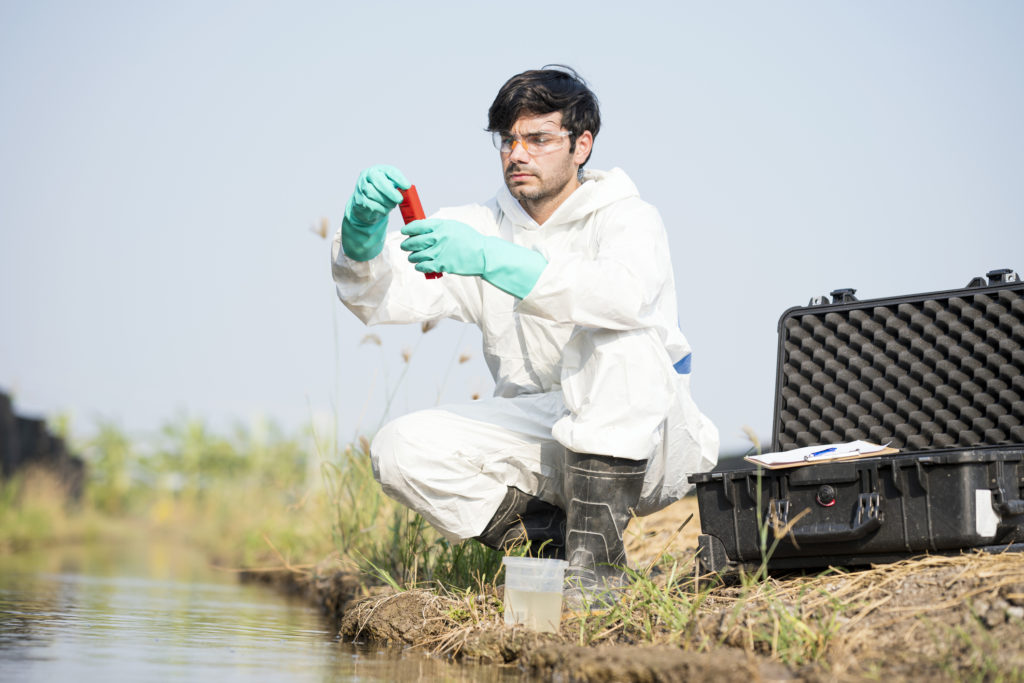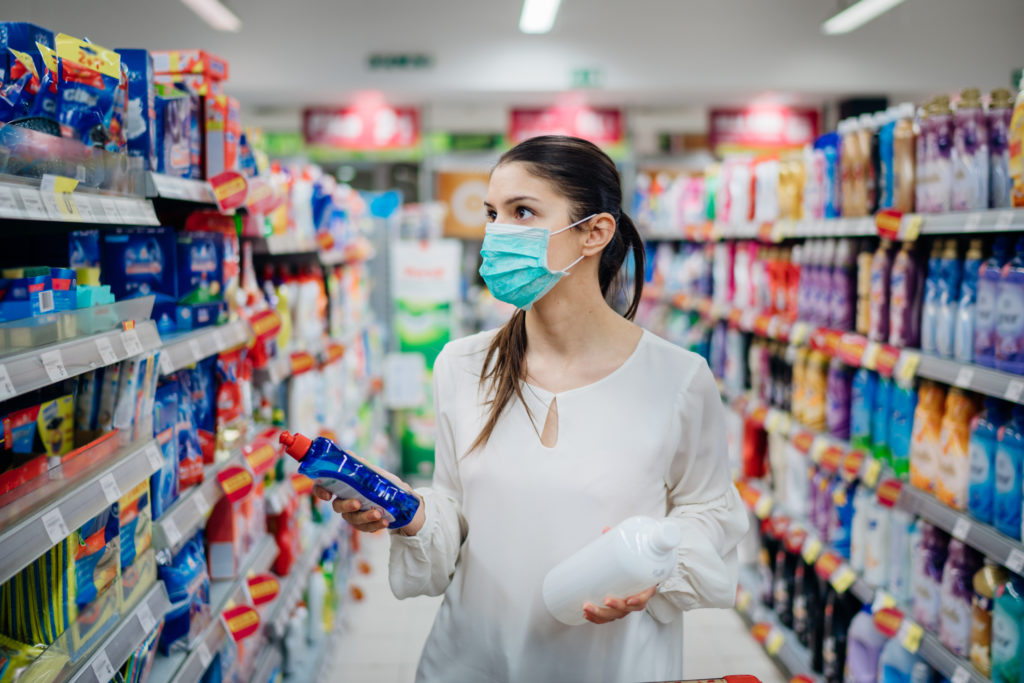Exposure to harmful chemicals is one of the environmental risks in Bosnia and Herzegovina (BiH) that is particularly dangerous to human health. However, it is crucial to note that people of different genders, occupations, locations, age or health status may be exposed to and affected by chemicals differently. For these reasons, environmental policymaking must consider that certain social groups are more vulnerable than others.
Harmful chemicals surround us almost everywhere – in food, clothing, cosmetics, electronic devices and cleaning products – and can enter the human body through different ways, such as inhalation, skin contact, consumption or injection. Both humans and the natural environment can suffer adverse impacts from chemicals. Research shows that hazardous chemicals and substances have already reached water, soil and food in BiH. Pollution comes mainly from inadequate municipal and industrial waste disposal, mines and hospitals, lack of wastewater treatment plants and sewage systems directly discharged into open water bodies. Continuous long-term exposure to hazardous chemicals in water, food, soil and air can lead to various health issues, such as damage to the reproductive, immunological and neurological systems, as well as cancer and organ-specific damage.

However, the negative effects of harmful chemicals on humans can reach beyond health issues. For instance, they can also lead to reduced working capacity and loss of income, increased healthcare expenses and even loss of income resulting from the death of a household member. Certain social groups are more vulnerable to adverse chemical impacts than others due to various reasons. Some are more vulnerable because of their health or limited ability to be protected from exposure to chemicals. There can also be social factors such as working and living locations that cause constant exposure to hazardous chemicals. Other social factors, such as healthcare access, also play a role in the ability of different groups to cope with chemical-related health issues.
Policy considerations needed
Considering the interactions between chemical safety and gender equality, social equity and poverty (GESEP) should be therefore more integrated in policymaking. There are differences in how different groups are exposed to and can cope with chemical substances because of formal and informal societal norms and behavioural considerations. There will also always be certain physiological differences in how different groups may be susceptible to harm from exposure to chemicals. Policies cannot change physiological differences, but they can be considered during risk assessments and setting acceptable exposure levels to protect relevant vulnerable groups.
Developing a new strategy and action plan for BiH
The development process of a new environmental strategy and action plan for Bosnia and Herzegovina (BiH ESAP 2030+) has acknowledged the interlinkages between chemical safety and social issues in several ways and have already considered them in the early stages of the process.
The chemical safety working group, which consists of diverse stakeholders and experts from different sectors who contribute to developing BiH ESAP at different jurisdiction levels, has regularly come together and discussed challenges and problems BiH faces, as well as measures and actions that are needed.
One of the project experts in chemical safety and noise, Melina Džajić – Valjevac, highlighted that all working group members had agreed about the need for relevant data regarding the consequences of human exposure to chemicals and chemical products, such as acute poisoning or chronic diseases resulting after continuous exposure. For instance, although it is generally known that women are more vulnerable to possible negative impact by using household chemicals and cosmetic products, there is no relevant data about this in BiH.
“Currently, health centres in BiH do not keep proper records about specific diseases that could be connected to continuous exposure to chemicals or chemical products. This results in that no measures are put in place to prevent further risk of acute or chronic poisoning. Acute poisoning is usually recorded under the same code as general injuries,” said Džajić – Valjevac.

Another project expert in chemical safety and noise, Borislav Malinović, pointed out that the working group members also emphasized the importance of raising public awareness about the importance of reading instructions and warnings on the packaging of chemical products written in accordance with classification, labelling and packaging (CLP) regulations. CLP is a European Union regulation from 2008 for systemizing classification, labelling and packaging of chemical substances and mixtures. Instructions on the packaging for the use of chemical products that are in concentrated quantities are especially important.
“In today’s Covid-19 pandemic, the risk of poisoning by biocides used as disinfectants is significantly expressed. This is especially pronounced for people who are employed in maintaining hygiene in different institutions. It is known that this occupation mainly employs women and people with a lower level of education who do not have a large income. Employees must know how to properly handle and use these chemicals that can cause serious health problems through improper use. Improper application of these chemicals in children under six years of age is especially dangerous,” said Malinović.
The value of capacity sharing
In addition to several working group discussions, various webinars have taken place to build capacity and give BiH local experts opportunities to learn from each other and individuals working with similar issues in other countries.
A webinar dedicated to GESEP issues included a deep dive in chemical safety by Jasminka Randelovic and Valentina Mart from the Alternative for Safer Chemicals (ALHem), an organization active in Serbia. They explained how gender and age can affect exposure to chemicals and their health impacts health due to biological and social factors. Gender norms influence the roles men and women play at home, the jobs they have and their level of exposure to different types of chemicals as a result. They also gave examples of possible gender-based impacts of chemical exposure on health, such as ovarian, breast, testicular and prostate cancers. Separately, they highlighted the impacts of exposure on fetuses and children.

In addition to gender and age, the experts highlighted that social status can influence exposure to chemicals as well, such as through dietary habits or housing quality.
During another webinar about chemical safety, the Swedish Chemicals Agency emphasized that since exposure to chemicals is different for all vulnerable groups, it is highly relevant to pay attention to prevention rather than try to fix the harm afterwards. There is a need for targeted awareness-raising campaigns for groups that are more vulnerable to the impacts of chemicals from environmental and occupational perspectives. It is also crucial to improve access to information on hazards and precautionary measures and promote safe usage of chemicals and phase-out of the most hazardous chemicals.

Important steps forward
Another important step is to have relevant policy responses. The experts highlighted the importance of biomonitoring given the lack of disaggregated data on health impacts of exposure to chemicals and the need to understand that gender-neutral policies will not benefit men and women equally.
Comprehensive mapping and assessment of chemical pollution hotspots and the collection of disaggregated data on occupational and environmental exposure are thereby essential for identifying and protecting populations at risk. Geographically detailed and disaggregated data are necessary to identify environmental inequalities, but policy interventions need to act on the data to address them. In addition, to reduce exposure to harmful chemicals, it is key to improve living standards for marginalized populations, address income poverty and strengthen the visibility and voice of disadvantaged groups.
The data about unintentional poisoning should be disaggregated by gender and age, added Džajić – Valjevac. “This is a critical first step in integrating GESEP considerations into sectoral policy in BiH because that will enable planning focused activities preventing risk on harmful impact by chemicals and chemical products,” she said. “On the other hand, BiH will be able to compare this data to other WHO member countries and apply to the different research programmes when and if this indicator shows a significant difference.”
As a result of the participatory process of developing the environmental strategy and action plan, the draft of the BiH ESAP 2030+ plan on chemical safety has incorporated several measures about GESEP. These measures are mostly about gathering disaggregated data on exposure.
This is an important step in the right direction in sectoral policymaking since BiH ESAP 2030+ is the first document tackling the issue simultaneously on the level of all jurisdictions in Bosnia and Herzegovina. It aims to become a milestone for sectoral policymaking and shaping the BiH environmental field for the next 10 years.
More information:
Find out more about waste management and social equity in the discussion brief “Chemical safety & noise pollution in Bosnia and Herzegovina: a gender equality, social equity and poverty reduction lens”
A broader introduction to the interlinkages between GESEP and different BiH environmental issues is available in this Q&A on the topic.







